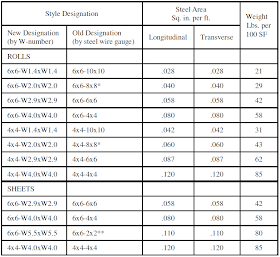The most common reinforcement associated with slabs-on-grade is welded wire fabric. However, this is not the only means of reinforcing slabs. In some cases deformed bars are used in order to assure that the reinforcement is placed at the correct depth within the slab and not damaged during placement. In either case when using deformed bars or welded wire fabric, it is essential that adequate support of the steel is provided.
Welded Wire Fabric
When using welded wire fabric, prefabricated sheets should be used in lieu of rolled fabric in order to help assure proper location of the steel within the concrete. In either case a minimum of one chair per 25 square feet of mesh should be used to adequately support the reinforcement above the sub-grade. The table provided in this slide lists common styles of welded wire fabric, including the “old” and "new" designations. Although the "new" designations are more than 20 years old, many engineers find this cross-reference helpful.
* Exact W-Number size for 8 gauge is W2.1.
** Exact W-Number size for 2 gauge is W5.4
** Exact W-Number size for 2 gauge is W5.4
Deformed Bars
The most common bar sizes encountered when using deformed reinforcement for typical lightly loaded slabs are #4 and #5 bars. However, it is recommended that #5 bars be used as a minimum as bars of smaller diameter are much more susceptible to damage due to foot traffic during the placing operation.
Post-Tensioning Tendons
Post-tensioning is very popular for slab-on-grade construction in some areas of the country. This is especially true for super-flat industrial floors and areas susceptible to expansive soil. The most common post-tensioning material is half-inch diameter 270k prestressing strand. The strand is generally greased and encapsulated in an extruded plastic sheathing. Post-tensioning precompresses the concrete, which in turn helps to control shrinkage cracking allowing for greater distances between joints.
Fiber Reinforcement
Synthetic fiberglass and steel fibers can also help to control plastic shrinkage cracking and limit the size of cracks when used according to the manufacturer's recommendations. However, currently there is no data indicating that the use of such fibers allows for an increase in joint spacing. In addition, currently ACI does not recognize fiber reinforcement as an acceptable substitute for conventional reinforcement. In addition, fiberglass fibers can sometimes protrude from the finish surface of the slab giving the concrete a “hairy” appearance.





